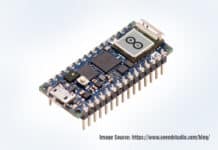The rx.el Emacs Lisp module provides s-expression notation for regular expressions. It is a macro that can generate regular expressions from readable s-expressions. This eleventh article in the GNU Emacs series explores the various s-expression counterparts and the regular expressions that get generated with numerous examples.
The rx.el Emacs Lisp module is written by Gerd Moellman and is included as part of GNU Emacs, which is released under the GNU General Public License v3.
Installation
The rx.el library is already included as part of GNU Emacs and you can simply require the same as shown below:
(require ‘rx)
We will use the s.el package available in Milkypostman’s Emacs Lisp Package Archive (MELPA) and in the Marmalede repo to demonstrate the examples. In particular, we will use thes-matches-p and s-match-strings-all functions provided by the s.el library. You can install this using the following command inside GNU Emacs:
M-x package-install s
Alternatively, you can copy the s.el source file to your Emacs load path to use it. If you are using Cask, then you can add the following to your Cask file:
(depends-on “s”)
After installation, you can require the s.el package using the following snippet:
(require ‘s)
Usage
Let us now explore the different s-expressions that can be used with the rx macro to generate regular expressions. The any construct matches any character in a SET. The latter may be a character or a string. In the following example ‘[0-9A-Fa-f]’ is the regular expression pattern that is generated.
(any SET ...) ;; Syntax (setq alphanumeric-pattern (rx (any "a-f" "A-F" "0-9"))) "[0-9A-Fa-f]" (s-matches-p (rx (any "a-f" "A-F" "0-9")) "A") t (s-matches-p (rx (any "a-f" "A-F" "0-9")) ";") nil
The s-matches-p function in the s.el library takes a regular expression and a string, and returns ‘true’ if there is a match and ‘nil’ otherwise. If an optional START argument is provided to it, then it starts the search from that index.
(s-matches-p REGEXP S &optional START) ;; Syntax
You can also use the in construct to generate the same ‘[0-9A-Fa-f]’ regular expression pattern as illustrated below:
(in SET ...) ;; Syntax (s-matches-p (rx (in "a-f" "A-F" "0-9")) "A") t
The and construct can be used to combine multiple s-expressions together. In the following example, line-start generates the ‘^’ (caret) character and is combined with zero or more occurrences of alphabets as shown below:
(and SEXP1 SEXP2 ...) ;; Syntax (rx (and line-start (0+ (in "a-z")))) "^[a-z]*"
If you want to match either of the s-expressions, you can use the or construct as illustrated below:
(or SEXP1 SEXP2 ...) ;; Syntax (s-match-strings-all (rx (or “Mary” “Peter” “John”)) “Mary had a little lamb”) ((“Mary”))
The s-match-strings-all function from the s.el library takes two arguments: a REGEX and a STRING. It returns a list of matches for REGEX in the given input STRING.
(s-match-strings-all REGEX STRING) ;; Syntax
The not rx-constituent can be used to generate a negative match. In the following example, a regular expression is generated to match a newline followed by anything that is not a blank.
(not SEXP) ;; Syntax (rx (and “\n” (not blank))) “\n[^[:blank:]]”
You can match for a specific character literally using the char construct. A couple of examples to match for the character ‘;’ are given below:
(rx (char ";")) ";" (s-matches-p (rx (char ";")) "ABC") nil (s-matches-p (rx (char ";")) "ABC;") t
The negate operation to not match a character is provided by the ‘not-char’ construct. For example:
(not-char SEXP1 SEXP2 ...) ;; Syntax (rx (not-char "A")) "[^A]" (s-matches-p (rx (not-char "A")) "B") t (s-matches-p (rx (not-char "A")) "A") nil
The actual code for not-char in rx.el is defined as follows:
(defconst rx-constituents ‘((... (not-char . (rx-not-char 1 nil rx-check-any)) ...))) (defun rx-not-char (form) “Parse and produce code from FORM. FORM is `(not-char ...)’.” (rx-check form) (rx-not `(not (in ,@(cdr form)))))
You can generate regular expressions from s-expressions to match for zero or more, one or more, and zero or one occurrences, as illustrated below:
(zero-or-more SEXP ...) ;; Syntax (one-or-more SEXP ...) ;; Syntax (zero-or-one SEXP ...) ;; Syntax (rx (zero-or-more “x”)) “x*” (s-matches-p (rx (zero-or-more “x”)) “yz”) t (s-matches-p (rx (zero-or-more “x”)) “xyz”) t (rx (one-or-more “x”)) “x+” (s-matches-p (rx (one-or-more “x”)) “yz”) nil (s-matches-p (rx (one-or-more “x”)) “xyz”) t (rx (zero-or-one “x”)) “x?” (s-matches-p (rx (zero-or-one “x”)) “yz”) t (s-matches-p (rx (zero-or-one “x”)) “xyz”) t
We have already seen the line-start construct that generates the caret symbol (^). Similarly, you can use the line-end construct to signify the end of a line, which is represented by the dollar sign ($). For example:
(rx “end” line-end) “end$” (s-matches-p (rx “end” line-end) “The end.”) nil (s-matches-p (rx “end” line-end) “The end”) t
A digit can be represented by using either digit, numeric or num constructs. A couple of examples are shown below:
(rx digit) “[[:digit:]]” (rx numeric) “[[:digit:]]” (rx num) “[[:digit:]]” (s-matches-p (rx num) “1234”) t (s-matches-p (rx num) “abcd”) nil
A control character is a non-printing character and you can use either control or cntrl constructs to generate the regular expression for the same. A few examples are given below:
(rx control) “[[:cntrl:]]” (rx cntrl) “[[:cntrl:]]” (s-matches-p (rx control) “\0”) t (s-matches-p (rx control) “abc”) nil
A hexadecimal digit can be matched by using either hex-digit, hex, or xdigit rx-constituents as illustrated below:
(rx hex-digit) “[[:xdigit:]]” (rx hex) “[[:xdigit:]]” (rx xdigit) “[[:xdigit:]]” (s-matches-p (rx digit) “1234”) t (s-matches-p (rx digit) “abcd”) nil
You can match for lower case characters using either lower or lower-case constructs. Similarly, you use upper or upper-case constructs to match for upper case letters. A few examples are shown below:
(rx lower) “[[:lower:]]” (rx lower-case) “[[:lower:]]” (rx upper) “[[:upper:]]” (rx upper-case) “[[:upper:]]” (s-matches-p (rx lower) “abc”) t (s-matches-p (rx lower-case) “;”) nil (s-matches-p (rx upper) “ABC”) t (s-matches-p (rx upper-case) “;”) nil
If you have escaped characters in your input text, you will need to use either regexp-quote or eval on the input before being able to apply the regular expression to match on the input string. An example is given below:
(eval FORM) ;; Syntax (setq input “\”Hello, world!\””) (not (s-matches-p input input)) nil (s-matches-p (regexp-quote input) input) t (s-matches-p (rx (eval input)) input) t
The rx.el library also provides support for non-ascii characters, such as multi-byte and accented characters. You can match for the same using the non-ascii construct as shown below:
(rx nonascii) “[[:nonascii:]]” (s-matches-p (rx nonascii) “ABC”) nil (s-matches-p (rx nonascii) “È”) t
The alpha-numeric rx-constituent can be used to match for both alphabets and numerals. A couple of examples are provided below for reference:
(rx alphanumeric) “[[:alnum:]]” (s-matches-p (rx alphanumeric) “abc123”) t (s-matches-p (rx alphanumeric) “;”) nil
If you want to match for only alphabets, then you can use the alpha construct. A few examples are shown below:
(rx alpha) “[[:alpha:]]” (s-matches-p (rx alpha) “ABC”) t (s-matches-p (rx alpha) “;;”) nil
You can search for a blank character using the blank construct. For example:
(rx blank) “[[:blank:]]” (s-matches-p (rx blank) “ “) t (s-matches-p (rx blank) “A”) nil
The space, white and whitespace rx-constituents can be used to match for white space as illustrated below:
(rx space) “[[:space:]]” (rx white) “[[:space:]]” (rx whitespace) “[[:space:]]” (s-matches-p (rx space) “ “) t (s-matches-p (rx space) “abc”) nil
The punct construct is used to match for punctuation marks. A couple of examples follow:
(rx punct) “[[:punct:]]” (rx punctuation) “[[:punct:]]” (s-matches-p (rx punct) “abc”) nil (s-matches-p (rx punct) “.”) t
You can match for a word using either the word or wordchar constructs. For example:
(rx word) “[[:word:]]” (rx wordchar) “[[:word:]]” (s-matches-p (rx word) “the”) t (s-matches-p (rx word) “ “) nil
If you do not want to match for a word, you can use the not-wordchar construct as follows:
(rx not-wordchar) “\\W” (s-matches-p (rx not-wordchar) “abc”) nil (s-matches-p (rx not-wordchar) “ “) t
The repeat construct takes two arguments: a number N and an s-expression. It repeatedly applies the s-expression N number of times to generate the regular expression. In the following example, we match for two occurrences of the letter ‘x’:
(repeat N SEXP) ;; Syntax
(rx (repeat 2 "x"))
"x\\{2\\}"
(s-matches-p (rx (repeat 2 "x"))
" ")
nil
(s-matches-p (rx (repeat 2 "x"))
"xxyz")
t
You can use group or group-n rx-constituents to capture groups of regular expressions. The first argument to group-n represents the group number, which is followed by the actual s-expression. In the following example, we create a regular expression to match the date in the MM-DD-YYYY format:
(group SEXP1 SEXP2 ...) ;; Syntax (group-n N SEXP1 SEXP2 ...) ;; Syntax (setq mm-dd-yyyy (rx (group-n 3 (repeat 2 digit)) “-” (group-n 2 (repeat 2 digit)) “-” (group-n 1 (repeat 4 digit)))) (s-match-strings-all mm-dd-yyyy “12-10-2019”) ((“12-10-2019” “2019” “10” “12”))
The generated regular expression pattern is‘\\(?3:[[:digit:]]\\{2\\}\\)-\\(?2:[[:digit:]]\\{2\\}\\)-\\(?1:[[:digit:]]\\{4\\}\\)’.
You are encouraged to read the information given in https://github.com/typester/emacs/blob/master/lisp/emacs-lisp/rx.el to know more about the available constructs provided by rx.el.
















































































